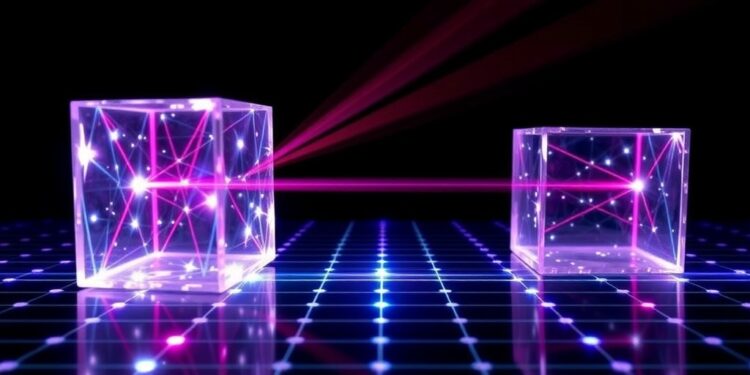Laser diodes are at the forefront of optical technology, harnessing semiconductor properties to emit and amplify light through a process known as optical feedback, which is achieved through multiple reflections inside the laser’s structure. These critically advanced components are further enhanced in a specific category of laser diodes, known as Photonic Crystal Surface-Emitting Lasers (PCSELs). Unlike conventional laser systems that rely on a singular mechanism for gain, feedback, and emission, PCSELs manage these functions distinctly within a photonic crystal framework. This distinction results in not only improved operational efficiency but also remarkable scalability and versatile design capabilities, opening doors to novel applications across various industries.
Recent breakthroughs in the understanding of light interactions within these sophisticated devices have been reported in a pivotal paper published within Volume 31, Issue 2 of the IEEE Journal of Selected Topics in Quantum Electronics. Released on November 20, 2024, the study outlines a novel methodology designed for the numerical simulation of light waves as they traverse triangular-lattice PCSEL structures. This innovative approach builds upon the foundational principles of photonic crystals, enhancing the understanding of two-dimensional light wave coupling, which is crucial for optimizing laser performance.
The researchers conducted a meticulous examination of a triangular-lattice configuration, which is characterized by its efficient grid-like structure. Their findings revealed that light wave interaction—the coupling effect—was significantly stronger within the triangular-lattice PCSEL compared to traditional square-lattice counterparts. This novel interaction manifests as enhanced optical feedback, a vital element for achieving efficient lasing processes. The implications of these findings underscore an exhilarating opportunity for advancements in laser technology, potentially leading to the development of devices that perform at unprecedented levels of efficiency.
Moreover, the researchers succeeded in deriving analytical equations pertinent to both mode frequencies and coupling constants. These equations not only enhance the theoretical framework for understanding triangular-lattice PCSELs but also serve as a practical tool for experimentalists seeking to validate their findings through empirical measurements. Professor Stephen John Sweeney, a senior IEEE member and co-author of the paper, emphasized the significance of these models, particularly for transverse magnetic (TM) triangular-lattice PCSELs. He noted that these equations greatly contribute to improving in-plane light coupling, which is essential for devices requiring low-index contrast.
The study also elucidated the general form of coupled wave equations, a critical advancement for unit cell design within crystal lattices. These equations will serve as instrumental guides in future experimental endeavors, driving further innovations in efficacious laser design. A notable achievement of this research was the identification of the “fundamental lasing mode” inherent to triangular-lattice PCSELs. This mode is characterized by an electromagnetic field pattern that yields optimal laser output, thus positioning the triangular configuration as a leading candidate for future photonic applications.
As the findings unfolded, the researchers drew parallels between the behaviors of TM and transverse electric (TE) polarizations. This comparative analysis highlighted the unique benefits that TM modes afford in low index contrast configurations, emphasizing a broadened scope for potential applications. This study serves not just to illuminate the realm of photonic crystal lasers but also to set a precedent for future research into new structures that may exploit the properties uncovered.
In the context of technological evolution, these derived analytical models and coupling equations lay a robust groundwork for experimental optimization within the field of photonics. Coupled with advances in computational methods, these insights will enable a new era of laser devices, characterized by unprecedented scalability and efficiency. The ability to tailor the optical characteristics of PCSELs precisely is poised to transform a host of industries—from telecommunications to medical applications—by facilitating the production of light sources that are more powerful, efficient, and capable of meeting burgeoning market demands.
In summary, this groundbreaking research sheds light on the superior properties of triangular-lattice PCSELs, fundamentally enhancing our comprehension of optical wave interactions in these devices. As scientists strive to pioneer even more advanced laser technologies, the foundation laid by these findings offers exciting prospects for further exploration and application.
This study not only propels the science of photonics forward but ignites imaginative possibilities for practical applications that could reshape how we utilize light in technology. The insights derived here are anticipated to resonate deeply within the scientific community, encouraging ongoing investigation and fostering innovative designs that leverage the newfound understanding of light interaction in photonic crystals.
As we stand on the cusp of potential breakthroughs enabled by this research, the future of laser technology and its vast applications appears bright, driven by the unyielding pursuit of knowledge and technological advancement.
Subject of Research: Understanding light interactions within Photonic Crystal Surface-Emitting Lasers, specifically triangular lattices.
Article Title: Two-Dimensional Coupled Wave Theory for Triangular Lattice TM-Polarised Photonic Crystal Surface Emitting Lasers.
News Publication Date: 20-Nov-2024.
Web References: https://doi.org/10.1109/JSTQE.2024.3502794.
References: IEEE Journal of Selected Topics in Quantum Electronics.
Image Credits: Not provided.
Keywords
Photonic crystals, laser light, electromagnetic waves, diodes, semiconductor lasers, optics, applied physics, condensed matter physics.
Tags: 2D light interactions in photonic crystalsadvanced laser diode technologiesbreakthroughs in laser performance analysisIEEE Journal of Selected Topics in Quantum Electronicsimproving operational efficiency in laserslight wave coupling optimizationmathematical approaches in laser technologynumerical simulation of light wavesoptical feedback mechanisms in lasersPhotonic Crystal Surface-Emitting Lasersscalable photonic crystal designstriangular-lattice PCSEL structures





